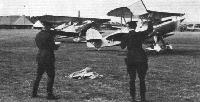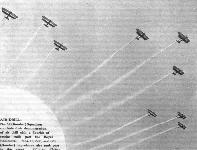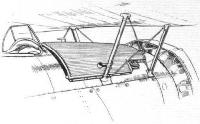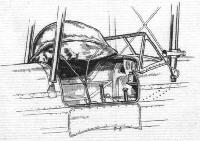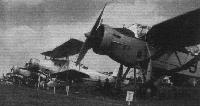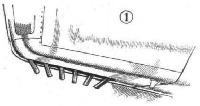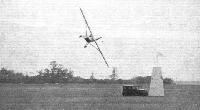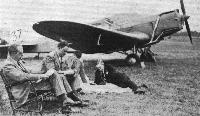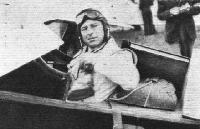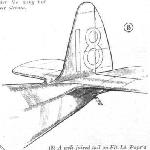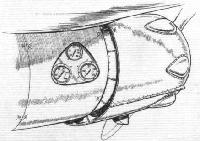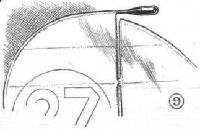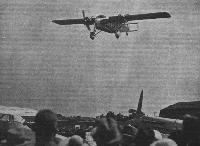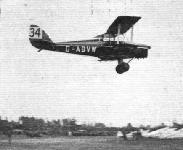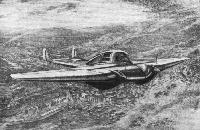Фотографии
-
FACING THE STARTER: The three Hawker machines "Fury," "Hart" and "Pegasus-Hart" about to take off.
Самолёты на фотографии: Hawker Fury - Великобритания - 1931Hawker Hart - Великобритания - 1928
-
AIR DRILL: No. 57 (Bomber) Squadron conclude their demonstration of air drill with a flourish of smoke trails past the Royal Enclosure. Nos. 18, 600, and 601 (Bomber) Squadrons also took part in this event.
Самолёты на фотографии: Hawker Hart - Великобритания - 1928
-
Types of Machine in the King's Cup Race (2) Miles "Hawk," D.H. "Gipsy III" 120 h.p. engine
Самолёты на фотографии: Miles Hawk / M.2 - Великобритания - 1932
-
Регистрационный номер: G-ACSW THE ONLY "THRILL": Mr. "Tommy" Rose overtakes Mr. Broadbent while rounding the Hatfield pylon.
Самолёты на фотографии: De Havilland Fox Moth / D.H.83 - Великобритания - 1932Miles Hawk / M.2 - Великобритания - 1932
-
THE ONLY LADY COMPETITOR: Mrs. G. Patterson was forced down near Peterborough by Friday's bad weather.
Самолёты на фотографии: Miles Hawk / M.2 - Великобритания - 1932
-
Another Selection of King's Cup Machines (5) Miles "Hawk" D.H. "Gipsy Six" 200 h.p. engine.
Самолёты на фотографии: Miles Hawk / M.2 - Великобритания - 1932
-
AN IMPRESSION: Thirteen hundred feet per minute is the initial rate of climb of the new "Hawk Major."
Самолёты на фотографии: Miles Hawk / M.2 - Великобритания - 1932
-
DESIGN AIDS TO SPEED (2) Another way of arranging the exhaust pipes on a "Gipsy Six" engine - in the Miles "Hawk M.2 " - also some details of the cantilever undercarriage of this machine.
Самолёты на фотографии: Miles Hawk / M.2 - Великобритания - 1932
-
DESIGN AIDS TO SPEED (5) On the "Hawk M.2" the balance is underneath but faired into the wing with this sprung "rat trap."
Самолёты на фотографии: Miles Hawk / M.2 - Великобритания - 1932
-
MORE SMOKE: Here all five of the "Skywriters" are seen designing beautiful coloured patterns on their blue "canvas."
Самолёты на фотографии: Bristol Bulldog - Великобритания - 1927
-
SMOKE: Three of the "Bulldogs" from No. 19 (Fighter) Squadron about to weave a spiral of orange, green and white smoke trails.
Самолёты на фотографии: Bristol Bulldog - Великобритания - 1927
-
FOR GUNNERY TRAINING: Three Bristol "Bulldog II.A" ("Jupiter VII.F.P.") of No.29 (Fighter Squadron) and a Fairey "Gordon" ("Panther II.A") start off to give a demonstration aerial target practice. The target is towed by the "Gordon," and the "Bulldogs" swoop down on the former and fire at it with their machine guns.
Самолёты на фотографии: Bristol Bulldog - Великобритания - 1927Fairey Gordon / Seal - Великобритания - 1931
-
THE DEFENDERS: No. 54 (Fighter) Squadron Bristol "Bulldog II.A" ("Jupiter VII.FP."), well disguised, take off to defend the Magazine against attack.
Самолёты на фотографии: Bristol Bulldog - Великобритания - 1927
-
WITH SLEEVE VALVES: The Bristol "Perseus" engine in the Bristol "Bulldog IV." The exhaust collector ring is faired into the engine cowl.
Самолёты на фотографии: Bristol Bulldog - Великобритания - 1927
-
THE CHAIRMAN: Mr. H. J. Thomas, of the Bristol Aeroplane Co., welcomed the guests at the official luncheon, first in English and then in French. He is seen here interrupted in the task of explaining to his young son some of the mysteries of the "Bulldog IV."
Самолёты на фотографии: Bristol Bulldog - Великобритания - 1927
-
Самолёты на фотографии: Bristol Bulldog - Великобритания - 1927
-
LEGS AND SILENCERS: The silencer of the Bristol "Perseus" sleeve-valve engine on the Bristol "Bulldog IV."
Самолёты на фотографии: Bristol Bulldog - Великобритания - 1927
-
Регистрационный номер: G-ACCD THE "SCIMITAR": A single-seater fighter of the Armstrong-Whitworth range. The engine is a 640-h.p. Siddeley "Panther."
Самолёты на фотографии: Armstrong Whitworth Scimitar / A.W.16 / A.W.35 - Великобритания - 1931
-
Регистрационный номер: K3574 FLYING BOATS: One of the most interesting events of the Display was the "fly past" of flying boats. Three of them are shown here - the Saunders-Roe R.24/31 (two Bristol "Pegasus") (left); the Short R.24/31 (two Rolls-Royce "Goshawk") (centre); and the Supermarine "Scapa" (two Rolls-Royce "Kestrel"), all of the open-sea reconnaissance multi-seater type. This photo was taken from another of the flying boats, the Blackburn "Perth" (three Rolls-Royce "Buzzard"), during rehearsals at Felixstowe.
Самолёты на фотографии: Blackburn Perth / R.B.3 - Великобритания - 1933Saunders-Roe London / A.27 - Великобритания - 1934Short Knuckleduster / S.18 - Великобритания - 1933Supermarine Scapa - Великобритания - 1932
-
NIGHT BOMBER AND TRANSPORT TYPES: In the foreground the nose of the Handley Page "Heyford." Flying past is the Vickers "Vellox."
Самолёты на фотографии: Handley Page Heyford / H.P.38 / H.P.50 - Великобритания - 1930Vickers Vellore / Vellox - Великобритания - 1928
-
"UNITED WE FLY": No. 25 (Fighter) Squadron on Hawker "Fury" (" Kestrel II.S") fly past "tied together." The connecting cords may be seen between the wing tips.
Самолёты на фотографии: Hawker Fury - Великобритания - 1931
-
A "DEAD STICK" APPROACH: Mr. Brie gliding the Autogiro in with the Siddeley "Genet Major" engine stopped.
Самолёты на фотографии: Cierva/Avro C.30A / Rota - Великобритания - 1932
-
AVROS AT THE S.B.A.C. DISPLAY: From front to back, the "Cadet," the Autogiro, the "Commodore," the 626, and the 642.
Самолёты на фотографии: Avro Cadet / Type 631/643 - Великобритания - 1932Avro Commodore / Type 641 - Великобритания - 1934Avro Tutor/Sea Tutor/Prefect / Type 621/646/626 - Великобритания - 1929Avro Type 642 - Великобритания - 1933Cierva/Avro C.30A / Rota - Великобритания - 1932
-
A "FOX" IN CHINA: A Fairey "Fox" Mk. IV (R.R. Kestrel IIs) is being demonstrated in China. The authorities are very impressed by the machine and have indicated that it is far ahead of anything they have seen. The most prominent figure in the picture is Colonel Wu, of the Kwangsi Air Force, who shot down a Japanese aircraft during the Sino-Japanese troubles at Shanghai. Colonel Wu has flown the "Fox."
Самолёты на фотографии: Fairey Fox - Великобритания - 1925
-
ON THE GLOSTER "GAUNTLET": The oil cooler on top of the fuselage deck.
Самолёты на фотографии: Gloster Gauntlet - Великобритания - 1929
-
THE ATTACK: A low-down "strafe" upon the Magazine by No. 13 (Army Co-operation) Squadron, while the balloon, forming part of the "apron," is brought down in flames
Самолёты на фотографии: Hawker Audax - Великобритания - 1931
-
FOR BLIND FLYING: The hood over the pupil's cockpit in the Blackburn B.6.
Самолёты на фотографии: Blackburn Shark / B-6 - Великобритания - 1933
-
IN THE LINE: The first machine is the Westland G.P. monoplane. Beyond may be recognised the Fairey G.P. and "Seal" and the Vickers "Vellox."
Самолёты на фотографии: Fairey G.4/31 - Великобритания - 1934Fairey Gordon / Seal - Великобритания - 1931Vickers Vellore / Vellox - Великобритания - 1928Westland PV.7 - Великобритания - 1933
-
SMOOTHING OUT THE AIRFLOW: A small auxiliary aerofoil is fitted above the wing of the Saro "Rapier-Cloud," with marked improvement in the effectiveness of the controls.
Самолёты на фотографии: Saunders-Roe Cloud / A.19 - Великобритания - 1930
-
ON TEST: View of the new Short "Singapore III" flying boat (4 Rolls-Royce "Kestrels") which recently underwent trials at Rochester. Note the clean running during take-off. The pilot was Mr. Lankester Parker.
Самолёты на фотографии: Short Singapore III / S.19 - Великобритания - 1934
-
Самолёты на фотографии: Short Singapore III / S.19 - Великобритания - 1934
-
Регистрационный номер: G-ACPM LARGEST OF THE LOT: Capt. Hubert Broad finishing a heat on the "Dragon Six"
Самолёты на фотографии: De Havilland Dragon Rapide / Dominie / D.H.89 - Великобритания - 1934
-
Самолёты на фотографии: Avro Tutor/Sea Tutor/Prefect / Type 621/646/626 - Великобритания - 1929
-
OXFORD UNIVERSITY AIR SQUADRON: A formation of "Tutors" over Canterbury. The squadron is doing its annual training at Eastchurch.
Самолёты на фотографии: Avro Tutor/Sea Tutor/Prefect / Type 621/646/626 - Великобритания - 1929
-
IN FORMATION: The Cambridge University Air Squadron on Avro "Tutors" over Salisbury Plain.
Самолёты на фотографии: Avro Tutor/Sea Tutor/Prefect / Type 621/646/626 - Великобритания - 1929
-
Регистрационный номер: G-ACPL, HK844 FOR IMPERIAL AIRWAYS: The D.H. 86 Delphinus, with four "Gipsy Six" 200-h.p. engines.
Самолёты на фотографии: De Havilland Express Air Liner / D.H.86 - Великобритания - 1934
-
Another Selection of King's Cup Machines (1) D.H. "Hornet Moth," D.H. "Gipsy Major" 130 h.p. engine.
Самолёты на фотографии: De Havilland Hornet Moth / D.H.87 - Великобритания - 1934
-
WHEN THE DROUGHT BROKE : The low-wing Monoplane Tendency was not appreciated by everyone.
Самолёты на фотографии: Percival Gull - Великобритания - 1932
-
Регистрационный номер: G-ABUR ACCURATE AND EFFICIENT: Mr. H. Halkos Percival "Gull" model and a detail of the four motors.
Самолёты на фотографии: Percival Gull - Великобритания - 1932
-
This is how a metal sheet is arranged to act as an air brake on the Percival "Gull."
Самолёты на фотографии: Percival Gull - Великобритания - 1932
-
LEGS AND SILENCERS: The new undercarriage of the Percival "Gull."
Самолёты на фотографии: Percival Gull - Великобритания - 1932
-
Регистрационный номер: G-ACND PRINCE GEORGES ENTRY: The Percival "Mew Gull" (Gipsy Six), although it averaged 191 m.p.h., was not fast enough to beat the handicappers.
Самолёты на фотографии: Percival Mew Gull - Великобритания - 1934
-
Types of Machine in the King's Cup Race (3) British Klemm "Swallow," Pobjoy "Cataract" 80 h.p. engine.
Самолёты на фотографии: Klemm L.25 - L.28 Swallow - Германия - 1927
-
Регистрационный номер: J-BISB A JAPANESE TRAINER: The Ishikawajima R-5 ("Hermes" IV), an improved version of the type used on the Tokio - London - Rome flight by Japanese students in 1931. The Japanese Army Air Force has ordered a batch for training purposes. A top speed of 118 m.p.h. is claimed.
Самолёты на фотографии: Ishikawajima R-5 - Япония - 1933
-
A DISTINCTIVE AMERICAN ENTRY: The Beechcraft A.17F entered by Miss Louise Thaden. It is fitted with a 690 h.p. Wright "Cyclone" engine, and, as will be seen, considerable attention has been given to the streamlining. The top plane has a big backward stagger, although this is not very apparent in our illustration.
Самолёты на фотографии: Beechcraft Model 17 Staggerwing - США - 1932
-
Регистрационный номер: G-ACRG IN A NEW WORLD: The British Klemm "Eagle" (Gipsy "Major") flying above the clouds.
Самолёты на фотографии: British Klemm BK-1 Eagle - Великобритания - 1934
-
Регистрационный номер: G-ACPU Another Selection of King's Cup Machines (4) British Klemm "Eagle," D.H. "Gipsy Six" 200 h.p. engine.
Самолёты на фотографии: British Klemm BK-1 Eagle - Великобритания - 1934
-
DESIGN AIDS TO SPEED (1) How the exhaust is led away underneath the cowling of the "Gipsy Six" engine in the Klemm "Eagle."
Самолёты на фотографии: British Klemm BK-1 Eagle - Великобритания - 1934
-
BRITISH KLEMM DETAILS: On the left is shown how the spruce ribs are stabilised with stringers and carried over the box spars. The right-hand sketch is a view of the special bracing over that portion of the wing into which the undercarriage wheel retracts.
Самолёты на фотографии: British Klemm BK-1 Eagle - Великобритания - 1934
-
WASTE NOT WANT NOT: In spite of following this excellent motto Mr. Cathcart Jones failed to gain a place in the race, although he did get Mr. Gandar Dower's "Puss Moth" into the Final.
Самолёты на фотографии: De Havilland Puss Moth / D.H.80 - Великобритания - 1929
-
Регистрационный номер: G-ACNZ NAPIERIAN LOGS: From left to right, Air Vice-Marshal Borton, Mr. Winter, Mr. Smith, Mr. Savage, and the "Rapier" in the "Courier."
Самолёты на фотографии: Airspeed Courier / AS.5 - Великобритания - 1933
-
Two views which show the Drag Bracing (left) and the Wing Joint (right). They are of the Airspeed "Courier" and differ only very slightly from the same details in the "Envoy." The Wing Joint is between the centre section and the outer wing extensions, the Drag Bracing comes between the wing spars.
Самолёты на фотографии: Airspeed Courier / AS.5 - Великобритания - 1933
-
Самолёты на фотографии: Airspeed Envoy / AS.6 - Великобритания - 1934
-
What the "Envoy" looks like on the ground. Landing lights are fitted in the leading edge of the wing of this machine, which was seen at the S.B.A.C. display at Hendon. The Wolseley engines are cowled with Townend rings.
Самолёты на фотографии: Airspeed Envoy / AS.6 - Великобритания - 1934
-
Регистрационный номер: G-ACMT AIRSPEED "ENVOY": This machine is fitted with two 185-h.p. Wolseley engines.
Самолёты на фотографии: Airspeed Envoy / AS.6 - Великобритания - 1934
-
This is what you see when looking into the pilot's cockpit through the bulkhead door in the passengers' cabin.
Самолёты на фотографии: Airspeed Envoy / AS.6 - Великобритания - 1934
-
A general view of the centre section unit of the "Envoy" showing the two mountings for the Wolseley engines, and the circular plywood bracing between the spars.
Самолёты на фотографии: Airspeed Envoy / AS.6 - Великобритания - 1934
-
A diagram of the retractable undercarriage of the "Envoy." When retracted the wheel protrudes about one third of its diameter beneath the wing. Both sides of this undercarriage are the same.
Самолёты на фотографии: Airspeed Envoy / AS.6 - Великобритания - 1934
-
HELPING HAND: Mr. Hillman uses his Rolls-Royce as a Tractor to bring out the M. & S.A.F. Avro 642 on to the tarmac.
Самолёты на фотографии: Avro Type 642 - Великобритания - 1933
-
DESIGN AIDS TO SPEED (3) A small curved guard on a D.H. "Leopard Moth," where the exhaust pipe was short, which served to keep the the fumes from coming up to the cockpit windows.
Самолёты на фотографии: De Havilland Leopard Moth / D.H.85 - Великобритания - 1933
-
DESIGN AIDS TO SPEED (6) The "Leopard Moth" also has the aileron balance under the wing but exposed to the air stream.
Самолёты на фотографии: De Havilland Leopard Moth / D.H.85 - Великобритания - 1933
-
The sharp leading edge to the wing and fairing cuffs on the wing struts of the Blackburn "B.2 Trainer."
Самолёты на фотографии: Blackburn B-2 - Великобритания - 1931
-
SAFETY FIRST: All R.A.F. pilots and observers are equipped with Irvin parachutes, and here we see a demonstration of a simultaneous drop from Vickers "Virginias" by the Parachute Section of the Home Aircraft Depot.
Самолёты на фотографии: Vickers Virginia - Великобритания - 1922
-
AERIAL SKITTLES: An amusing and original event was that in which Vickers "Virginia" bombers of No. 99 (Bomber) Squadron flew low over a row of big skittles and endeavoured to "bowl" them over with their bombs. Here we see what was almost a direct hit.
Самолёты на фотографии: Vickers Virginia - Великобритания - 1922
-
Регистрационный номер: G-ABWW THE FAST MACHINES: The last three entrants in the races were considerably faster than the rest of the machines. Here we see Capt. Dancy (with the flag) and Mr. Rowarth starting Mr. Cook in his Gipsy "Major" engined Comper "Swift."
Самолёты на фотографии: Comper Swift / CLA.7 - Великобритания - 1930
-
A TIGHT FIT: Flt. Lt. Pope housed his parachute in the luggage locker of the Comper "Swift."
Самолёты на фотографии: Comper Swift / CLA.7 - Великобритания - 1930
-
DESIGN AIDS TO SPEED (8) A well-faired tail on Flt. Lt. Pope's Comper "Swift."
Самолёты на фотографии: Comper Swift / CLA.7 - Великобритания - 1930
-
Регистрационный номер: G-ACRK FOR ARCTIC AIR ROUTE: Mr. John Grierson's "Fox Moth" being launched at Rochester, where it was equipped with floats by Short Bros. Mr. Grierson left on Friday on his flight along the Arctic Air Route to Ottawa.
Самолёты на фотографии: De Havilland Fox Moth / D.H.83 - Великобритания - 1932
-
Регистрационный номер: S1578 A MIGHTY HUNTER: A Hawker "Nimrod" (R.R. "Kestrel" II's) on floats. The "Nimrod" is the Standard fleet fighter of the RAF, and in its landplane form has a top speed of over 190 m.p.h.
Самолёты на фотографии: Hawker Nimrod - Великобритания - 1931
-
Регистрационный номер: G-ACUV EFFICIENCY: With two Pobjoy "Niagara" engines of 90 h.p. each, the Short "Scion" carries pilot and five passengers at a cruising speed of 100 m.p.h.
Самолёты на фотографии: Short Scion / S.16 - Великобритания - 1933
-
The rev. counter, oil-temperature and oil-pressure gauges, as seen from the cabin of the Short "Scion."
Самолёты на фотографии: Short Scion / S.16 - Великобритания - 1933
-
THIRTY-TWO PASSENGERS - 174 M.P.H.: The Fokker F.XXXVI is fitted with four Wright "Cyclone" engines which give it a top speed of about 174 m.p.h.
Самолёты на фотографии: Fokker F.XXXVI / F.XXII - Нидерланды - 1934
-
SOMETHING LARGE AND NEW: Here is the recently-completed Fokker F.XXXVI 32-passenger monoplane for K.L.M., fitted with four Wright "Cyclone" engines. Actual performance figures are not yet available, but the estimated top speed is 168 m.p.h. and the cruising speed 142 m.p.h. The range at cruising speed is expected to be about 870 miles.
Самолёты на фотографии: Fokker F.XXXVI / F.XXII - Нидерланды - 1934
-
LONG-DISTANCE COMFORT: On the left is shown a compartment of the new Fokker equipped for flying by day, and on the right the same arranged for night travel.
Самолёты на фотографии: Fokker F.XXXVI / F.XXII - Нидерланды - 1934
-
Регистрационный номер: G-ACTS LANDING, The Monospar "S.T.10" landing at Hatfield. The new, complete cowling of the two Pobjoy engines is neat and clean.
Самолёты на фотографии: General Aircraft Monospar ST-4 - ST-12 - Великобритания - 1932
-
THE WINNER: Flt. Lt. Schofleld crossing the finishing line in his Monospar "S.T.10" (two Pobjoy 90 h.p. "Niagara" engines) after covering the course of the Final at more than 135 m.p.h.
Самолёты на фотографии: General Aircraft Monospar ST-4 - ST-12 - Великобритания - 1932
-
THE LATEST VERSION: General Aircraft Co.'s S.T.10 has two 90-h.p. Pobjoy "Niagara" engines.
Самолёты на фотографии: General Aircraft Monospar ST-4 - ST-12 - Великобритания - 1932
-
PLEASED: Flt. Lt. H. M. Schofleld carried as passenger throughout the race Mr. H. J. Stieger, the designer of the machine and the inventor of the Monospar system of wing construction.
Самолёты на фотографии: General Aircraft Monospar ST-4 - ST-12 - Великобритания - 1932
-
THE THIRTEENTH: Mr. Jackaman's Monospar was No. 13 in the thirteenth King's Cup Race, and he was "eliminated" on July 13th. He is seen here checking the "revs." of his Pobjoy engines.
Самолёты на фотографии: General Aircraft Monospar ST-4 - ST-12 - Великобритания - 1932
-
Types of Machine in the King's Cup Race (5) Monospar "S.T.10," two Pobjoy "Niagara" 90 h.p. engines.
Самолёты на фотографии: General Aircraft Monospar ST-4 - ST-12 - Великобритания - 1932
-
S.T.10 FUSELAGE DETAILS: The centre portion of the "S.T.10's" fuselage is built up as a unit of steel tubes. The details show how the girder forming the rear portion is made from drawn sections.
Самолёты на фотографии: General Aircraft Monospar ST-4 - ST-12 - Великобритания - 1932
-
CONSTRUCTIONAL DETAILS of the Monospar "S.T.10." The lettering shows the parts of the main structure to which the small sketches refer. This new model has only one door to the cabin but the whole top opens up as well, making getting in and out a very simple and easy matter.
Самолёты на фотографии: General Aircraft Monospar ST-4 - ST-12 - Великобритания - 1932
-
A MASS BALANCE: To conform with Air Ministry requirements, ailerons must have a mass balance. This is how it is fitted to the S.T.10.
Самолёты на фотографии: General Aircraft Monospar ST-4 - ST-12 - Великобритания - 1932
-
Monospar "S.T.10" 2 Pobjoy (90 h.p.) "Niagara" Engines
Самолёты на фотографии: General Aircraft Monospar ST-4 - ST-12 - Великобритания - 1932
-
DESIGN AIDS TO SPEED (9) The mass balance on the rudder of the Hendy "Hobo."
Самолёты на фотографии: Hendy Hobo - Великобритания - 1929
-
UNLUCKY BUT UNDISMAYED: Capt. G. de Havilland (right) and his two sons, Geoffrey and Peter, had little luck in the race, but Geoffrey did get into the Final on "T.K.1" as fifth.
Самолёты на фотографии: De Havilland Technical School T.K.1 - Великобритания - 1934
-
A GOOD EFFORT: The "T.K.1" designed and built by students of the de Havilland Technical School was flown into the Final by G. de Havilland, Jun.
Самолёты на фотографии: De Havilland Technical School T.K.1 - Великобритания - 1934
-
Another Selection of King's Cup Machines (3) DH Technical School "T.K.I," D.H. "Gipsy III" 120 h.p. engine.
Самолёты на фотографии: De Havilland Technical School T.K.1 - Великобритания - 1934
-
COMPER'S UNDERCARRIAGE: Both the Comper "Streak" and the new Comper "Kite" have their undercarriages retracted straight back by mechanical means.
Самолёты на фотографии: Comper Streak / Kite - Великобритания - 1934
-
DESIGN AIDS TO SPEED (4) Shows how Flt. Lt. Comper arranges the aileron balance and pilot head on the wing tip of his "Kite."
Самолёты на фотографии: Comper Streak / Kite - Великобритания - 1934
-
DESIGN AIDS TO SPEED (7) On the rudder of both his "Streak" and "Kite," Flt. Lt. Comper arranges the mass balance as an arc working through a slot in the fin.
Самолёты на фотографии: Comper Streak / Kite - Великобритания - 1934
-
ICH DIEN": H.R.H. the Prince of Wales arriving at the R.A.F. Display in his Vickers "Viastra" (two Bristol "Pegasus" engines). It is to be hoped that the practical example set by the Prince will encourage considerable numbers of the 100,000 or so who saw his arrival at Hendon to make more extensive use of air travel.
Самолёты на фотографии: Vickers Viastra / Type 160 - Великобритания - 1930
-
Регистрационный номер: G-ABKY FOR FREIGHT WORK: Wrightson & Pearse, of Heston, are to use a Vickers "Vellox" (two Pegasus ) on special freight work. The "Vellox" carries a load of 5,300 lb. and has a maximum speed of 160 m.p.h.
Самолёты на фотографии: Vickers Vellore / Vellox - Великобритания - 1928
-
Регистрационный номер: G-ABVW [2] FINISHING THIRD: Mr. L. Lipton crosses the finishing line as third in the King's Cup Race and winner of the Siddeley Trophy.
Самолёты на фотографии: De Havilland Moth Major / D.H.60GIII - Великобритания - 1932
-
Регистрационный номер: G-ABVW [2] GOOD CORNERING: Mr. L. Lipton, on his "Gipsy III Moth," was third in the King's Cup Race and winner of the Siddeley Trophy.
Самолёты на фотографии: De Havilland Moth Major / D.H.60GIII - Великобритания - 1932
-
Регистрационный номер: X962Y FOR FEEDER LINES: The Lockheed "Alcor" high-wing monoplane.
Самолёты на фотографии: Alcor Duo-4 / Duo-6 - США - 1930
-
Lockheed "Alcor"
Самолёты на фотографии: Alcor Duo-4 / Duo-6 - США - 1930
-
FIRST FOUR PLACES: The Caudron "Rafale" C.50 monoplane (140 h.p. Renault 4-cyl. in line inverted air-cooled engine), which, piloted by Lacombe, won the "12 Hours of Angers" contest. This type also secured second, third and fourth places in this contest.
Самолёты на фотографии: Caudron C.430 Rafale - Франция - 1934
-
SOUTH AFRICAN-BUILT: Mr. Lewis Noble, of South Africa, and his small parasol monoplane.
Самолёты на фотографии: Noble monoplane - ЮАР - 1933
-
HOME MADE! Riley Burrows with the machine in which he covered a three-mile triangular circuit at 185 m.p.h. near Los Angeles. Its wing span is 11 feet.
Самолёты на фотографии: Burrows R-5 - США - 1934
-
ALL AUSTRALIAN. This etching by Mr. E. Warner shows the "All-Australian" machine, which is being built in Sydney, as it would appear flying over Circular Quay, Sydney. The machine was designed by Mr. T. D. J. Leech, B.Sc, M.I.Ae.E., A.M.I.E., and Mr. L. J. R. Jones. It is to be of all-metal construction and will have two Australian Harkness Hornet engines.
Самолёты на фотографии: Harkness & Hillier All Australian - Австралия - 1934
Статьи
- Flight
